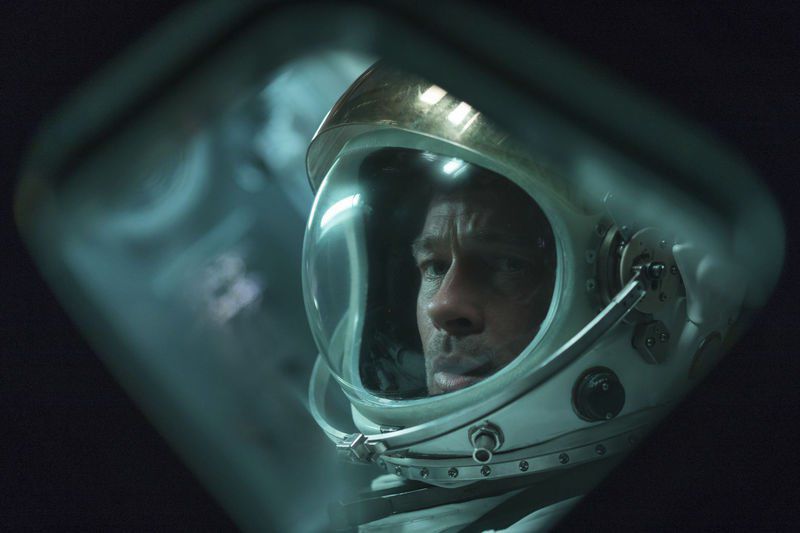ALEXXANDAR MOVIE REVIEWS: ‘Ad Astra’ falls short of the stars
Published 10:00 am Saturday, September 28, 2019

- This image released by 20th Century Fox shows Brad Pitt in a scene from 'Ad Astra.'
“Ad Astra” (Science-Fiction/Drama: 2 hours, 2 minutes)
Starring: Brad Pitt, Tommy Lee Jones and Donald Sutherland
Trending
Director: James Gray
Rated: PG-13 (Violence and strong language)
Movie Review: Ad Astra is the Latin term for to the stars. Director James Gray takes moviegoers there with beautiful visualizations, yet his and writer Ethan Gross’ screenplay is mild.
The men rush vital story elements that are replaced by a surplus of unneeded subplots and overdone narration. The visuals of space, however, offer enough to temporarily distract.
Thirty years ago, Mission Cmdr. Col. Clifford McBride, Ph.D. (Jones) led a vessel into deep space to find intelligent life beyond the Sol system. The crew was never heard from again, but something near Neptune is sending back powerful electrical surges that could destroy Earth.
Trending
Major Roy R. McBride, the colonel’s son, now a valiant astronaut, too, leads a team to find his father somewhere near Neptune. In order for Major McBride to reach his father, he embarks on an adventurous mission of importance with inherent dangers.
“Per ardua ad astra,” translated through adversity to the stars, may have been a better title for this movie. Brad Pitt’s Major McBride encounters multiple tribulations to reach his estranged father. James Gray (“The Immigrant,” 2013; “The Lost City of Z,” 2016) leads a production team, creating marvelous visuals. They hide some of the film’s messier components and questionable story elements.
The movie is filled with superfluous scenes of Pitt’s character narrating what he is feeling and what he expects. The narration is irritating, although Pitt’s performance is sound.
The movie also shows how humanity has reached the stars but still fighting for resources. The screenplay shows the solar system in which its players reside. That is OK, but these scenes digress from the story. Some appear as filler, commercials to energize the monotonous moments and elongate “Ad Astra’s” runtime. These moments also make this movie appear a hodge-podge of genres as if “Ad Astra” is part sci-fi, part horror and part Buck Rogers à la a Stanley Kubrick film.
The producers of this science-fiction feature do some things brilliantly. They give audiences grand visuals that excite. The scenic views of the cosmos are eye candy. These scenes also give audiences an adventure into the unknown while making one wait for the apex of this story. This is “Ad Astra’s” greatest feat.
It is an artistic movie with a statement about humanity in the future. The movie shows commercialization of the moon as a seemingly big mall, and Mars as a neglected second Earth suburb. The writers create a universe more fascinating than the main story, a man tracking down his father and the entity sending destructive wave toward Earth.
“Ad Astra” is also a movie about a son’s emotional bonds with his father. Pitt is brilliant as that son. His regally handsome face and monotone expressions are pivotal. He excels in this role. This role and his earlier portrayal this year of a stuntman in “Once Upon a Time In Hollywood” are some of his best moments. He is physical in “Hollywood” and mentally keen in “Ad Astra.” Pitt shows that 2019 is his year.
So if one finds themselves in this movie’s audiences, go see it for the artistic adventure of majestic visualizations. That is its beauty along with Pitt’s engaging performance. Otherwise, one might be disappointed by its slow-paced story and arthouse genre feel.
Grade: B- (An artful journey into the cosmos with adjacent excursions.)
“Rambo: Last Blood” (Action/Thriller: 1 hour, 29 minutes)
Starring: Sylvester Stallone, Adriana Barraza and Yvette Monreal
Director: Adrian Grunberg
Rated: R (Strong graphic violence, gore, drug use and profanity)
Movie Review: “Rambo: Last Blood,” a sequel to “First Blood” (1982) and subsequent sequels: “Rambo: First Blood Part II” (1985), “Rambo III” (1988) and “Rambo” (2008, directed Sylvester Stallone), is a revenge film that never reaches a convincing point. This fifth movie in the franchise exists because of nostalgia, but that does nothing to facilitate a weak story and poorly combined and edited scenes.
Vietnam War veteran John Rambo (Sylvester Stallone) manages his late father’s horse ranch in Bowie, Ariz. Rambo’s niece, Gabrielle (Monreal), and her grandmother, Maria Beltran (Barraza), help manage the ranch.
Despite warnings, Gabrielle goes to Mexico to meet the father who abandoned her and her deceased mother years ago. Shortly after, Rambo discovers Gabrielle has been abducted by a Mexican drug cartel that traffics women.
The character of Rambo is an all-American hero. One cheers for him, even in a bad movie. His story this outing needs more development. Character development is thin. A significant character dies, and the scene generates little emotion. That character, like others, suffers from underdevelopment, which lacks a compelling reason to care.
Sylvester Stallone returns, appearing as fit as ever. He is good to see back on screen as Rambo, but the story this outing is lackluster. The acting is poor. The plot hurries to get to an all-action, very violent ending with middling returns.
Grade: C- (Hopefully, the last …)
“Downton Abbey” (Drama: 2 hours, 2 minutes)
Starring: Maggie Smith, Hugh Bonneville, Michelle Dockery and Elizabeth McGovern
Director: Michael Engler
Rated: PG-13 (Thematic elements, suggestive material, and language)
Movie Review: “Downton Abbey” is based on characters created by Julian Fellowes, a continuation of the television serious that ran from 2010-15. The movie is invitingly charming. Its enticing soundtrack a gateway to a nice escape. This soap-operatic drama offers gratifying returns, although many scenes appear episodic, as if waiting for a commercial.
The lives of nobles and their servants are chronicled at Downton Abbey, the mansion of the Crawleys, a large estate in the English countryside during the early 20th century. The lives of the Crawleys and their servants change when King George V and Queen Mary, the grandparents of England’s Queen Elizabeth II, make a royal visit. The family and staff of Downton Abbey are in an elated state about the news, but the stately visit also comes with royal pains.
Fans of television should be pleased. Moviegoers who have never watched the series should also be pleased. “Downton Abbey” supplies beautiful visuals of a 20th century England. Series creator and screenplay writer Julian Fellowes’ characters, setting and story are inviting.
This is a grand soap opera. That is the film’s only weakness. Some scenes are not smooth transitions to the next scene much like television. This is what television director Michael Engler (“30 Rock” and “Sex and the City”) knows.
Scenes cease briefly with characters pausing as if waiting for a commercial. These moments have the appearance of episodes in this manner. This is not necessarily a terrible thing. Such a technique keeps the story moving briskly. If this movie had commercials, the endearing characters, especially Maggie Smith, are worthy enough for one to return after each advertisement break.
Grade: B (Visit this regal place.)
Adann-Kennn Alexxandar works and lives in Valdosta.





